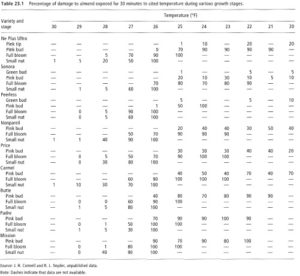There is a frost risk for the next few nights with temperatures dropping into the high 20’s and maybe lower. If these forecasts are true, crop loss could be experienced within colder areas of almond orchards.
As written previously, there are some tasks that can be performed to help reduce the risk of frost damage. These include mowing the cover crop or residual vegetation to allow radiant heat form the soil to move into the canopy, use of sprinkler systems to apply water which warms the orchard, or utilization of equipment or fans to help move warmer air into the orchard. All of this is to help increase orchard temperatures by 2-3 degrees.
The risk of frost increases as almonds break dormancy and begin development. Dormant buds are relatively tolerant to freezing conditions, but sensitivity increases as flowers develop from pink bud to full bloom, then into nutlets. The following figure selected from “The Almond Production Manual,” developed by Joe Connell and Richard Snyder, demonstrates the change in sensitivity. Essentially, sensitivity does vary slightly by variety, but a 50% or greater of crop loss can be experienced during bloom when temperatures drop to 27F for 30 minutes. After petal fall, this temperature threshold increases to 28F. Colder temperatures can cause significant crop loss.

Implementation of frost protection measures should be considered when temperatures approach freezing as orchards are often colder than forecasted temperatures. Mowing must be done prior to the frost event. Irrigation systems applying water during the night will provide a heating effect even with a wet soil surface due to heat being released off the water as it freezes. In essence, with these systems, more water equals more protection. Targeted amounts of water should be 30-40 gallons per minute per acre. Minimally, water should be applied at rates higher than 15 gallons/minute/acre to avoid freezing of the spaghetti tubing/ irrigation lines.
Temperatures are often the coldest an hour or two before dawn. Irrigation systems should be turned on a few hours before the expected coldest period. Make sure pumps are checked prior to expected frost event to make sure they are working.


Bob Beede
February 23, 2017Great Information, David! Also VERY timely! Well done!!
David Doll
February 23, 2017Thanks Bob. Hope we pull through this w/o incident.
David
Andre Tolmachoff
February 24, 2017Very helpful post David!
One question: when spraying fungicide at night (to protect bees) how cold is too cold? I read the Merivon label but did not see any reference to spraying at low temperatures
David Doll
March 14, 2017As long as the spray doesnt freeze, you should be okay. My guess is that would be below 28-29F.
David
Stan Cutter
February 20, 2018Thanks Dave,
A year later and this article is still timely!
Stan.
David Doll
February 26, 2018Thanks, Stan.
Glad it was useful.
David
Brent Demnar
October 2, 2018Hi David, I’ve just found and read your February 2017 article concerning Almond Frost Sensitivity. Great information here. We are dealing with frost losses on Australian Almond Orchards as a result of frosts in the 2017 season and again in the current season and I have a question which you may or may not be prepared to offer comment on. While we have no problem identifying frost damage, given that frost will kill an affected bud, it seems to us that repeated exposures to chill temperatures, that is very low temps that don’t quite reach freezing level, also have an impact on the crop when it is at the post flower/small nut stage. We are finding small nuts still on the tree a month past the frost event, which struck at full bloom, that show discoloured (browning) kernel fluid and which are progressively falling off. It is perhaps associated with natural shed, but given the quantity being aborted on trees which had already lost a significant number of buds to frost, we’re not sure whether that’s the case.
I would really appreciate your views if possible.
David Doll
November 3, 2018Brent,
Exposure to near lethal temps for several night shouldn’t affect the viability of the crop, but may affect the various physiological processes – such as pollination and fertilization. I dont believe, however, this to be the issue with the low crop set. My guess is that temperatures experienced within the orchard actually dropped below freezing, but werent accurately recorded. Temperatures can vary significantly within orchards due to how cold air moves. In CA, we have seen as much as 5 degree (C) swings from areas within a field. Could this be possible?
Thanks,
David
Frost damage to almonds - The Almond Doctor
March 5, 2023[…] Flower sensitivity to cold damage has been studies. Additional information on this can be found here. […]